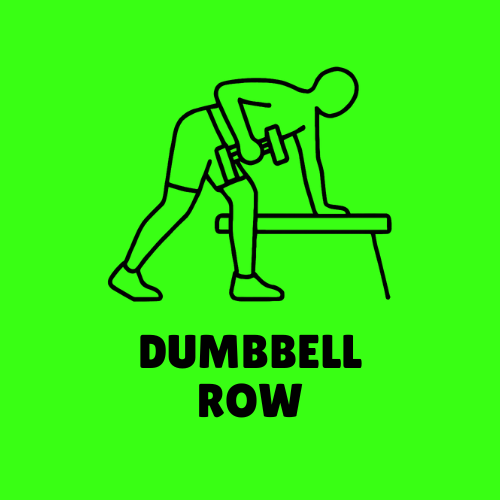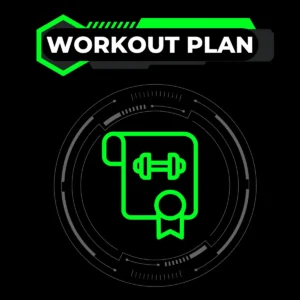What is a Dumbbell Row?
The dumbbell row is a strength-training exercise that involves pulling a dumbbell towards your body while maintaining a bent-over position. It’s a versatile movement that can be tailored to suit a variety of fitness levels and goals.
Purpose of the Dumbbell Row
The primary purpose of the dumbbell row is to strengthen the back muscles. It’s a pulling motion that mimics daily functional movements, such as picking up objects or pulling doors open, making it practical and beneficial beyond the gym.
Benefits of Dumbbell Rows
- Targeted Back Development: This exercise effectively isolates and strengthens the lats, traps, and rhomboids.
- Improved Posture: Strengthening the back muscles helps combat the effects of poor posture caused by prolonged sitting or desk work.
- Enhanced Athletic Performance: this exercise improve pulling strength, which is crucial for athletes in sports like swimming, rowing, and rock climbing.
- Versatility: Suitable for all fitness levels, dumbbell rows can be adapted with different weights, tempos, or grips.
The Muscles Worked in Dumbbell Rows
Understanding the muscles engaged during dumbbell rows can help you maximize their effectiveness and ensure a balanced workout routine.
Primary Muscles
- Latissimus Dorsi (Lats): These large muscles along the sides of your back are the primary movers in dumbbell rows.
- Trapezius (Traps): Located across the upper back, traps support scapular movement and shoulder stability.
Secondary Muscles
- Rhomboids: These muscles retract the scapula and help maintain proper shoulder alignment.
- Rear Deltoids: Located at the back of your shoulders, they assist in pulling motions.
- Biceps: While not the main target, your biceps assist in pulling the weight.
- Core Muscles: Maintaining a stable position during the exercise engages your abdominals and obliques.
To explore and discover the best fitness tools that can enhance your performance and workouts, visit our Fitness Calculator category on the website.
Equipment Needed for Dumbbell Rows
The equipment requirements for dumbbell rows are minimal, making them an accessible exercise for home gyms and fitness centers alike.
- Dumbbells: Available in various weights and styles, dumbbells are the cornerstone of this exercise.
- Bench or Stable Surface: Essential for single-arm dumbbell rows, a bench provides support and balance.
- Optional Accessories:
- Lifting Straps: Useful for heavier weights to reduce grip fatigue.
- Gloves: To enhance grip and prevent calluses.
Proper Form for a Dumbbell Row
Correct form is crucial for maximizing results and preventing injuries. Here’s a detailed breakdown:
Step-by-Step Guide
- Starting Position:
- Stand with your feet shoulder-width apart.
- Hold a dumbbell in one hand, allowing it to hang at arm’s length.
- Place your opposite hand and knee on a bench for support, creating a stable base.
- Execute the Row:
- Pull the dumbbell towards your torso, keeping your elbow close to your body.
- Squeeze your shoulder blade at the top of the movement for maximum muscle engagement.
- Lower the Dumbbell:
- Gradually return the dumbbell to the starting position in a controlled manner.
- Avoid dropping the weight or letting momentum guide the motion.
Key Tips for Proper Form
- Keep your back straight and avoid rounding your spine.
- Engage your core throughout the movement to maintain stability.
- Focus on the muscles being worked rather than just moving the weight.
Alternative Exercises for Dumbbell Row
If you’re looking to diversify your back workout or need alternatives to the dumbbell row, here are four effective exercises to target similar muscle groups. These movements can help you build a stronger back and enhance your overall fitness routine.
1. Barbell Row
The barbell row is a compound exercise that engages the entire back, as well as the biceps and core. Unlike the unilateral nature of dumbbell rows, the barbell row uses both arms simultaneously, allowing you to lift heavier weights.
- How to Perform:
- Hold a barbell with an overhand grip, hands slightly wider than shoulder-width.
- Bend your knees slightly and hinge at your hips, keeping your back flat.
- Pull the barbell toward your torso, squeezing your shoulder blades together at the top.
- Lower the barbell slowly and repeat.
2. T-Bar Row
The T-bar row is another excellent back exercise that provides support for your lower back while targeting the lats, traps, and rhomboids. It’s ideal for lifting heavy weights with a reduced risk of strain.
- How to Perform:
- Place a barbell in a T-bar row station or landmine attachment.
- Straddle the bar and grip the handles with both hands.
- Hinge at your hips, keeping your chest up and back flat.
- Pull the handles toward your chest, squeezing your shoulder blades together.
- Slowly return to the starting position.
3. Seated Cable Row
This exercise isolates the back muscles while minimizing strain on the lower back. It’s great for achieving a full range of motion and consistent tension throughout the movement.
- How to Perform:
- Sit on a cable row machine with your feet securely placed on the platform.
- Grab the handles with both hands and sit upright with a slight bend in your knees.
- Pull the handles toward your torso, keeping your elbows close to your body.
- Squeeze your shoulder blades together at the peak of the movement.
- Slowly return to the starting position.
4. Pull-Ups
Pull-ups are a bodyweight exercise that effectively targets the lats, traps, and biceps. They also engage your core and improve grip strength.
- How to Perform:
- Grab a pull-up bar with an overhand grip, hands slightly wider than shoulder-width apart.
- Hang with your arms fully extended and legs straight.
- Pull your chest toward the bar, focusing on engaging your back muscles.
- Lower yourself slowly back to the starting position.
Incorporating these alternatives into your training routine can help you avoid plateaus, target different areas of your back, and keep your workouts exciting and effective. Each exercise has its unique benefits, so choose the ones that align best with your fitness goals!
Dumbbell Row vs Barbell Row
Both dumbbell rows and barbell rows are excellent exercises for building back strength, but they have unique features that make them suitable for different goals and training preferences. Below, we explore the differences between the two exercises and compare them in a detailed table.
Key Differences Between Dumbbell Rows and Barbell Rows
- Unilateral vs. Bilateral Movement: Dumbbell rows allow for unilateral movement (one arm at a time), which is great for correcting muscle imbalances. In contrast, barbell rows are a bilateral movement, working both sides of the body simultaneously.
- Range of Motion: Dumbbell rows often provide a greater range of motion, allowing for a deeper stretch and more targeted engagement of back muscles. Barbell rows have a slightly restricted range due to the fixed barbell.
- Weight Load: Barbell rows typically allow for heavier loads, making them ideal for strength and mass-building. Dumbbell rows prioritize stability and muscle isolation.
| Feature | Dumbbell Row | Barbell Row |
|---|---|---|
| Range of Motion | Greater; allows a deeper stretch | Limited by the barbell’s range |
| Muscle Symmetry | Each arm works independently, reducing imbalances | Both sides share the load |
| Stabilizer Muscle Engagement | Higher; requires stabilization for each dumbbell | Lower; barbell offers more inherent stability |
| Weight Load Capacity | Typically lighter due to stabilization needs | Can lift heavier weights for strength gains |
| Versatility | Allows for variations like neutral grip | Limited to standard grip positions |
| Core Engagement | Greater core activation to stabilize the body | Less core activation; focus on back strength |
| Suitability for Beginners | More beginner-friendly due to lighter loads | More challenging for beginners due to weight |
When to Choose Each Exercise
- Dumbbell Row: Ideal for targeting muscle imbalances, improving range of motion, and engaging stabilizer muscles. It’s also excellent for individuals recovering from injuries or looking to enhance muscle control.
- Barbell Row: Best for advanced lifters focusing on strength and mass gains. Its bilateral nature makes it suitable for lifting heavier weights and incorporating into high-intensity programs.
By understanding the unique benefits and mechanics of each, you can incorporate both exercises into your routine for a well-rounded back workout.
Common Mistakes to Avoid
Even experienced lifters can fall into bad habits. Avoid these common errors to ensure you get the most out of your dumbbell rows:
- Using Momentum: Swinging the dumbbell reduces muscle activation and increases the risk of injury.
- Incorrect Back Position: A rounded or overarched back can strain your spine. Always maintain a neutral spine.
- Neglecting Core Engagement: A weak core can lead to instability, reducing the effectiveness of the exercise.
1 Arm Dumbbell Row Explained
The 1 arm dumbbell row is a staple variation that isolates one side of the body, allowing for focused strength development.
Benefits of 1 Arm Dumbbell Rows
- Unilateral Strength Development: Helps correct imbalances between your left and right sides.
- Improved Stability: Engages the core more effectively due to the asymmetrical load.
- Increased Range of Motion: Allows for a deeper pull, enhancing muscle engagement.
How to Perform the 1 Arm Dumbbell Row
- Place one knee and hand on a bench for support.
- Hold a dumbbell in the opposite hand.
- Pull the dumbbell towards your waist, keeping your elbow close to your body.
- Lower the weight slowly, ensuring control throughout the movement.
2 Arm Dumbbell Row Technique
The 2 arm dumbbell row is an efficient variation that works both sides of the body simultaneously.
Advantages of the 2 Arm Dumbbell Row
- Saves time by targeting both sides at once.
- Increases overall upper-body strength.
How to Perform
- Hold a dumbbell in each hand with your palms facing inward.
- Bend forward at the hips while keeping your back straight.
- Pull both dumbbells towards your torso, squeezing your shoulder blades together.
- Lower the dumbbells back to the starting position in a controlled manner.
The 45-Degree Incline Row
The 45-degree incline row is a unique variation that reduces strain on the lower back while targeting the same muscle groups.
How to Perform the 45-Degree Incline Row
- Adjust a bench to a 45-degree angle.
- Lie face down on the bench with a dumbbell in each hand.
- Pull the dumbbells towards your sides, squeezing your shoulder blades together.
- Slowly lower the dumbbells back to the starting position.
Benefits of the Incline Row
- Reduces stress on the lower back.
- Promotes better form due to the supported position.
Other Names of Dumbbell Row
The dumbbell row is known by various other names depending on the variation or region. Common terms include:
- Single-Arm Row
- Bent-Over Row
- Dumbbell Bent-Over Row
- One-Arm Row
These alternative names highlight subtle differences in form, setup, or execution.
Conclusion
The dumbbell row is a versatile, effective exercise that belongs in every strength-training routine. By mastering its variations, such as the 1 arm dumbbell row, 2 arm dumbbell row, and 45-degree incline row, you can target your back muscles, improve posture, and build strength. Whether you’re just starting or looking to elevate your workouts, incorporating dumbbell rows will take your fitness journey to the next level.
Elevate Your Back Training: Must-Read Resources
The dumbbell row is a cornerstone exercise for developing a strong, defined back. If you want to gain a deeper understanding of back muscle anatomy and how to optimize your workouts, check out this comprehensive guide on ExRx.net.
For those seeking advanced techniques and variations, visit Bodybuilding.com for expert insights. This resource caters to all levels, whether you’re just starting out or are an experienced lifter aiming to refine your form.
Remember, maintaining proper form and prioritizing safety are essential to prevent injuries and ensure effective training. For reliable advice on exercise safety and guidelines, refer to the trusted resource Mayo Clinic.
Looking for more exercises to strengthen your back muscles? Explore our Back Exercise Library, featuring detailed guides, workout plans, and expert tips tailored to help you make steady progress and achieve your fitness goals.
For a complete collection of exercises targeting every muscle group, visit our Exercise Library. Discover in-depth guides and specialized workouts to enhance your overall performance and support your fitness journey!
FAQs
Can Dumbbell Rows Help Improve Posture?
Yes, dumbbell rows can aid in improving posture by strengthening the upper back muscles, including the rhomboids and trapezius. These muscles are crucial for retracting the shoulder blades and maintaining an upright posture, counteracting the effects of prolonged sitting or slouching.
What are the benefits of performing dumbbell rows unilaterally (one arm at a time)?
Performing dumbbell rows unilaterally allows for greater focus on each side of the back, helping to correct muscle imbalances and improve overall symmetry. This approach also enhances core stability, as the body must engage the core muscles to maintain balance during the movement.
How does the dumbbell row compare to the barbell row in terms of muscle activation and safety?
While both exercises target the back muscles, dumbbell rows offer a greater range of motion and allow for unilateral training, which can address muscle imbalances. They also place less stress on the lower back compared to barbell rows, making them a safer option for individuals with lower back concerns.



